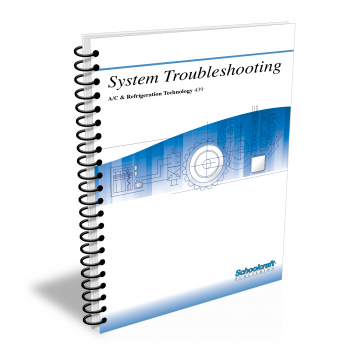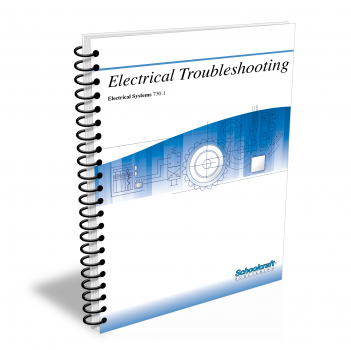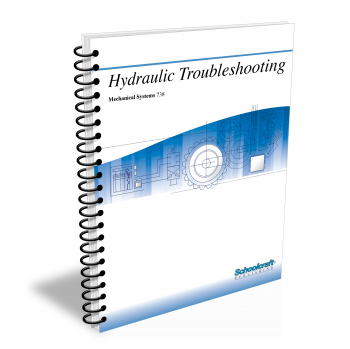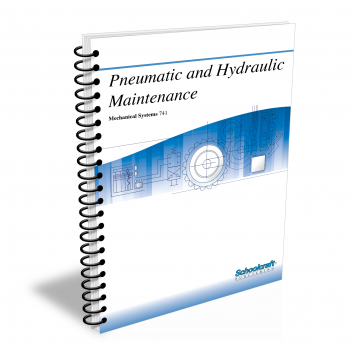Troubleshooting Skills
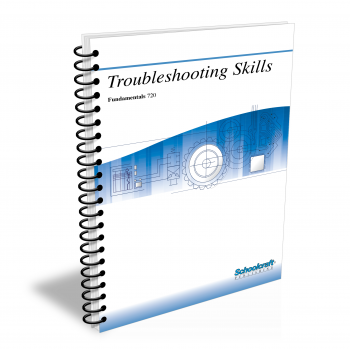
Course Number: 720
The Troubleshooting Skills textbook explores the subject of troubleshooting and the importance of proper maintenance procedures. It covers working with others, aids in communication, and trade responsibilities. It also outlines troubleshooting techniques and aids, focusing on specific maintenance tasks, breakdown maintenance, and planned maintenance.
Does your curriculum require additional topics not included in this textbook? Build a customized version of the Troubleshooting Skills textbook below.
This textbook has been recently updated
to include topics lists, objectives, & key terms for every chapter.
Recommended Contact Hours – 15
Preview a Chapter
Available Supporting Material
- Table of Contents
- Exam Copies
- Suggested Titles
Table of Contents
Chapter 1: Introduction to Troubleshooting
Topics: Troubleshooting skills, duties, aids; Mechanical and electrical troubleshooting; Maintenance organizations and personnel; Scheduling
Learning Objectives:
- Tell why efficient troubleshooting is important in a production plant.
- Name the four common troubleshooting aids.
- List the steps in troubleshooting a machine.
- List the steps in troubleshooting a system.
- Describe a typical maintenance organization.
Chapter 2: Working with Other People
Topics: Communication; People skills; Aids to communicating; Differences of opinion; You and your supervisor; Upgrading your skills
Learning Objectives:
- Tell why good communication between plant personnel is needed.
- List the ways a person usually sees himself/herself.
- Explain the communication cycle.
- Explain the correct method of delivering a written message from your supervisor to another person.
Chapter 3: Troubleshooting Techniques
Topics: Job responsibilities; Recognizing normal operations; Testing and observation; Reducing downtime; Routine and emergency repairs
Learning Objectives:
- List the steps to recognizing normal machine operations.
- List the questions you should ask yourself when a machine fails.
- List the signs of a machine in need of service.
Chapter 4: Aids to Troubleshooting
Topics: Drawings, blueprints, and sketches; Manufacturer's literature; Service reps; Planned-maintenance records; Work orders; Test equipment
Learning Objectives:
- Describe a blueprint.
- List the information that should be recorded in a machine equipment record.
- Identify calibration standards.
- Identify a multimeter (VOM).
- Identify different troubleshooting test equipment.
Chapter 5: Preparing for Troubleshooting
Topics: Tools, parts, and supplies; Safety rules; Using charts and diagrams; Correcting malfunctions; Keeping records
Learning Objectives:
- List the information you must know about mechanical or electrical systems before you can troubleshoot them successfully.
- Name the commonly used items that should be carried in every troubleshooter's tool box.
- List the steps to follow in reading a pneumatic or hydraulic schematic.
- List the responsibilities of a troubleshooter.
Chapter 6: Using Schematics and Diagrams
Topics: Piping, compressor, and engine schematics; Hydraulic, pneumatic, and electrical schematics; Lighting diagrams; Troubleshooting charts
Learning Objectives:
- Discuss how to use schematics when troubleshooting.
- Identify differences in schematics.
- Explain how to use a troubleshooting chart.
Chapter 7: Solving Mechanical Problems
Topics: Bearing, pump, and piping problems; Compressed-air, refrigeration, and pollution-control equipment; Hydraulic systems; HVAC
Learning Objectives:
- Identify bearing wear problems.
- Identify pump failure problems and solutions.
- Identify types of hosing.
- Identify different plant equipment and their problems.
Chapter 8: Solving Electrical Problems
Topics: Generation and distribution; Feeders and branch circuits; Fuses and circuit breakers; Testing for continuity; Safety; Troubleshooting
Learning Objectives:
- State the definition of switchgear.
- Identify current voltage characteristics of wire.
- List the safety rules to follow when working with electrical equipment.
- Identify a pictorial diagram, a block diagram, and a schematic diagram.
- Explain how to troubleshoot an electric problem.
Chapter 9: Breakdown Maintenance
Topics: Work-order procedures; Preparing for emergencies; Skills for emergency work; Using downtime
Learning Objectives:
- Explain what to do if you are the first member of the emergency crew.
- Explain the spare parts requisition form.
- Discuss the four main parts of practical machine maintenance.
Chapter 10: Planned Maintenance
Topics: Frequency and benefits; Unscheduled maintenance; Keeping records, Lubrication charts and tags
Learning Objectives:
- State the definition of planned maintenance.
- List the information that should be included on record sheets or file cards as part of the machine inventory.
- List the benefits to be accrued from an effective lubrication program.
- Describe the proper sag in a drive chain.
- Explain how to service a battery properly.
Request Exam Copies
Exam Copies
Ready to see a copy of our textbooks? After selecting which textbooks you’d like to review for your course, you can submit your request by either logging in or creating an account so we know where to ship your exam copies. A representative from Schoolcraft will contact you to confirm and finish processing your request.
Exam copies are always free and yours to keep.
Selected Exam Copies
none selected
* Maximum of five copies can be ordered
